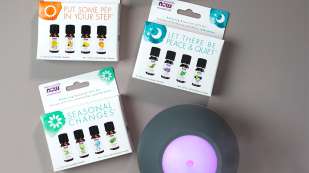Use coupon code MOISTURIZER with your purchase of $40 or more for a free†
Blemish Clear MoisturizerHow Packaging Contributes to Product Quality

High quality products require high quality packaging
At NOW we go to great lengths to ensure the quality of our natural products by purchasing ingredients from reputable suppliers around the world and conducting numerous in-house and third party lab tests prior to approval for production. Another less publicized quality initiative is NOW's commitment to state-of-the-art packaging materials.
Without superior packaging, high quality ingredients would not remain stable throughout the established shelf life. NOW stocks over 200 packaging components, ranging from plastic resin bottles, films, fiber canisters, glass bottles, and more. Each package component has specific attributes to protect NOW's line of more than 1,400 natural products.
The product determines the packaging
The majority of NOW products are packaged in plastic resins. We use special types of resin, depending on each product and its specific needs. None of our packaging is polycarbonate or epoxy, which are the plastics of concern for BPA. We only use PETE and HDPE, and also require our suppliers to use BPA-free packaging. Polyethylene terephthalate (PET) is used for items sensitive to light and oxygen. PET provides superior protection against oxygen permeation.
Items susceptible to water degradation are packaged in high density polyethylene (HDPE) due to the powerful barrier properties against moisture. Internal tests confirm the effectiveness of HDPE using moisture indicators in high humidity conditions. We use HDPE for a variety of products, including probiotics, for several reasons:
- HDPE is Bisphenol-A (BPA) free.
- HDPE provides a strong moisture barrier comparable to glass (low moisture is key to probiotic stability).
- HDPE resins are known for their high strength-to-density ratio, which makes them tougher than other types of plastic.
- Plastic bottles are light weight, which makes them easier to transport. This results in lighter loads, less breakage, fewer trucks, reduced transportation energy, decreased emissions and lower shipping cost.
- HDPE bottles resist moisture, mold, mildew, rotting, and insects.
- HDPE creates no harmful emissions during its production or during its use by the consumer. It also does not leach toxic chemicals into the soil or water.
- Unlike more transparent forms of plastic, HDPE is opaque and thus more resistant to heat.
NOW uses films for many items that are packaged in bags or packets. Each film used by NOW contains several layers, creating a protective barrier.
Although costly, NOW uses amber tinted glass bottles for certain products requiring complete protection from light, moisture, and rapid oxidation, such as our essential oils and liquid herbal extracts.
When appropriate we use composite canisters for certain products. This form of packaging is suitable for all kinds of products due to the multi-layered walls and strong body. NOW’s canisters contain paperboard, foil, and plastic layers, providing excellent protection from light, oxygen, and moisture. Lecithin and other environmentally sensitive products are ideal for this form of packaging.
Recycling is very important
NOW is dedicated to using 100% post-consumer recycled (PCR) resin packaging when available to support our high-quality products. PCR allows us to re-use recycled packaging materials and lighten our footprint on the earth. In 2023, NOW began the transition of all white supplement bottles to PCR. Moving forward, the Solutions, Pets and Sports lines will also introduce PCR packaging when available.
NOW is a strong recycling advocate and uses recyclable packaging, such as recycled paperboard and corrugated boxes, whenever possible. Most of the plastics that NOW uses are recyclable. NOW recycles any form of packaging used in operations and uses it for further processing if it meets industry Good Manufacturing Practices.
Maintaining Freshness
NOW takes packaging to another level by placing inserts into products with labile (easily altered) properties. NOW was the first company to introduce an Ageless® oxygen packet into products susceptible to oxidation (natural degradation due to oxygen) with extremely effective results. Internal tests consistently result in 99% oxygen reduction in PET bottles.
Desiccants are substances that attract water. These substances are packaged in small plastic containers or packets and are commonly inserted in products that are sensitive to moisture. The majority of our herbal products contain desiccants in order to control the moisture levels until the package is opened.
Some natural products are especially sensitive to moisture. For these products we employ a stronger moisture-control insert known as a molecular sieve. Molecular sieves are typically tiny plastic inserts that contain a material with numerous tiny pores of uniform size. Due to the size of these pores, only molecules of a certain size can enter the sieve. Molecular sieves are manufactured with pores of various, specific sizes to attract certain molecules, such as water.
Consumers may also find additional inserts in certain NOW products, such as cotton to protect the integrity of tablets and charcoal for those ingredients with strong odors.
Packaging and safety
Consumer safety is always a top priority at NOW, and packaging plays an important role. Every product produced by NOW contains one or more forms of tamper-evident seals to provide consumers with an extra layer of protection. Tamper-evident seals include hinge guard lids, heat induction and pressure sensitive seals, shrink-wrap, and even stickers. NOW places child-proof caps on all products containing moderate to high levels of iron to avoid accidental poisoning.











